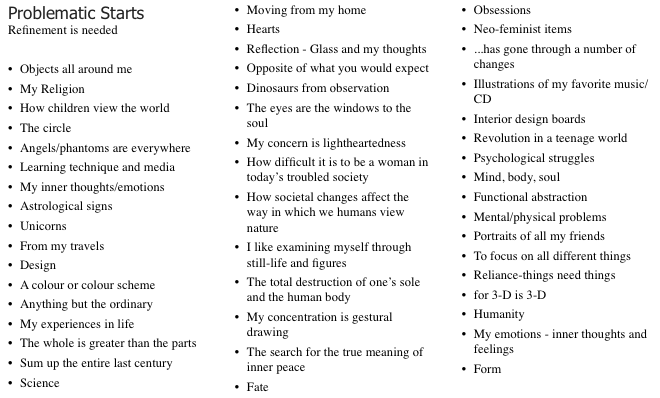Lists
Concentation – Best Practices
- Create a plan that focuses on your talent, strengths, interest, and passions in order to complete a selection of 12 pieces for your concentration
- Formulate a plan for growth and development (e.g., use a different colour scheme for each piece). View how artists use colour. Study colour theory.
- Plan to spend at least 10 hours on each piece and at least one week per piece.
- Use materials you are already familiar with (e.g., pencil, coloured pencil, acrylic paint).
- Show a full value range with high contrast.
- Create unique compositions. Vary perspective by using bird’s eye view, bug’s view, foreshortening, etc.
- Work in layers. Allow time for media to dry then layer. Don’t abandon a start, instead combine two starts.
Avoid teenage stereotypes:
- blood dripping
- moisture from eyes
- skulls
- rock, rap, or any stars
- large eyes
- fashion models
- muscle men
- comic book style drawing
- comic strip characters
Avoid cliches:
- palm tree/sunset
- sun or sunrays in corner
- sunset with mountain
- lollipop trees
- rainbow and clouds
- sad clowns
- tears/eyes
Explore a variety of styles:
- abstraction
- realism
- surrealism
- cubism
- impressionism
- cultural influences
- primitivism
- modern
- dynamism
- fauvism
 Adapted from: Sunday, B. (2011). Introduction to AP studio art. Unpublished manuscript, AP Studio Art Session, Presented by Barbara Sunday, Sentinel Secondary School, West Vancouver, Canada
Adapted from: Sunday, B. (2011). Introduction to AP studio art. Unpublished manuscript, AP Studio Art Session, Presented by Barbara Sunday, Sentinel Secondary School, West Vancouver, Canada
